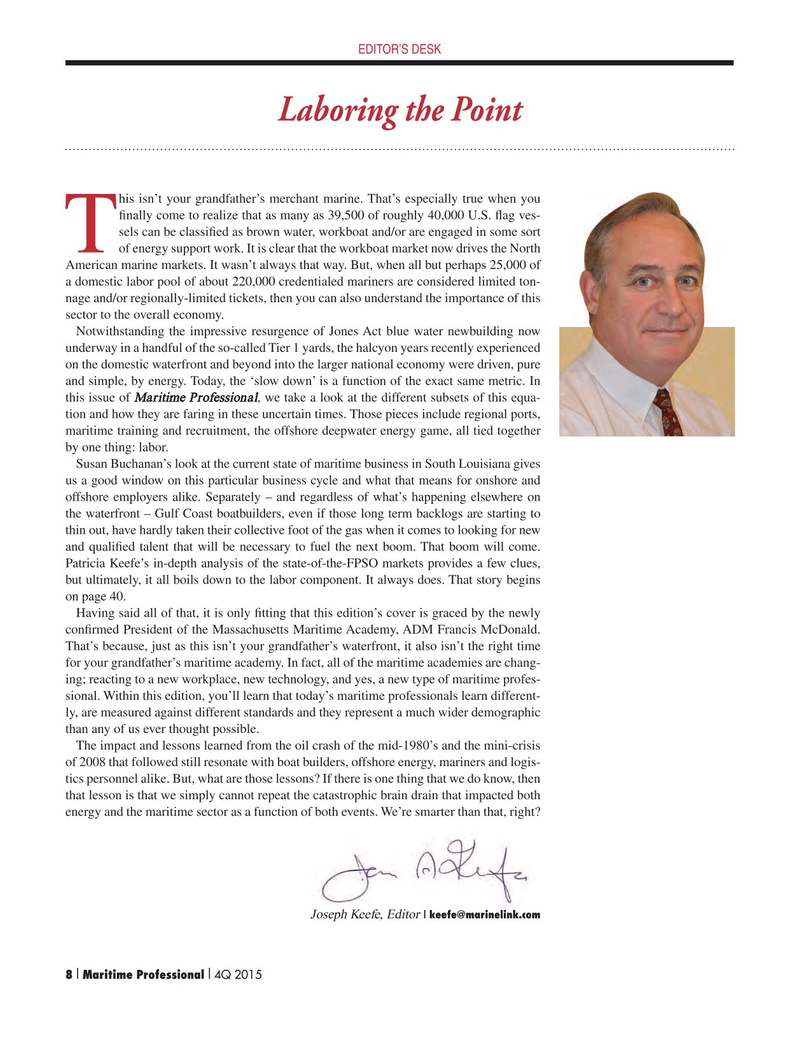
Page 8: of Maritime Logistics Professional Magazine (Q4 2015)
Read this page in Pdf, Flash or Html5 edition of Q4 2015 Maritime Logistics Professional Magazine
EDITOR’S DESK
Laboring the Point his isn’t your grandfather’s merchant marine. That’s especially true when you ? nally come to realize that as many as 39,500 of roughly 40,000 U.S. ? ag ves- sels can be classi? ed as brown water, workboat and/or are engaged in some sort
T of energy support work. It is clear that the workboat market now drives the North
American marine markets. It wasn’t always that way. But, when all but perhaps 25,000 of a domestic labor pool of about 220,000 credentialed mariners are considered limited ton- nage and/or regionally-limited tickets, then you can also understand the importance of this sector to the overall economy.
Notwithstanding the impressive resurgence of Jones Act blue water newbuilding now underway in a handful of the so-called Tier 1 yards, the halcyon years recently experienced on the domestic waterfront and beyond into the larger national economy were driven, pure and simple, by energy. Today, the ‘slow down’ is a function of the exact same metric. In this issue of Maritime Professional, we take a look at the different subsets of this equa- tion and how they are faring in these uncertain times. Those pieces include regional ports, maritime training and recruitment, the offshore deepwater energy game, all tied together by one thing: labor.
Susan Buchanan’s look at the current state of maritime business in South Louisiana gives us a good window on this particular business cycle and what that means for onshore and offshore employers alike. Separately – and regardless of what’s happening elsewhere on the waterfront – Gulf Coast boatbuilders, even if those long term backlogs are starting to thin out, have hardly taken their collective foot of the gas when it comes to looking for new and quali? ed talent that will be necessary to fuel the next boom. That boom will come.
Patricia Keefe’s in-depth analysis of the state-of-the-FPSO markets provides a few clues, but ultimately, it all boils down to the labor component. It always does. That story begins on page 40.
Having said all of that, it is only ? tting that this edition’s cover is graced by the newly con? rmed President of the Massachusetts Maritime Academy, ADM Francis McDonald.
That’s because, just as this isn’t your grandfather’s waterfront, it also isn’t the right time for your grandfather’s maritime academy. In fact, all of the maritime academies are chang- ing; reacting to a new workplace, new technology, and yes, a new type of maritime profes- sional. Within this edition, you’ll learn that today’s maritime professionals learn different- ly, are measured against different standards and they represent a much wider demographic than any of us ever thought possible.
The impact and lessons learned from the oil crash of the mid-1980’s and the mini-crisis of 2008 that followed still resonate with boat builders, offshore energy, mariners and logis- tics personnel alike. But, what are those lessons? If there is one thing that we do know, then that lesson is that we simply cannot repeat the catastrophic brain drain that impacted both energy and the maritime sector as a function of both events. We’re smarter than that, right? | [email protected]
Joseph Keefe, Editor 8 Maritime Professional 4Q 2015I I 1-17 Q4 MP2015.indd 8 11/18/2015 10:22:43 AM

 7
7

 9
9
